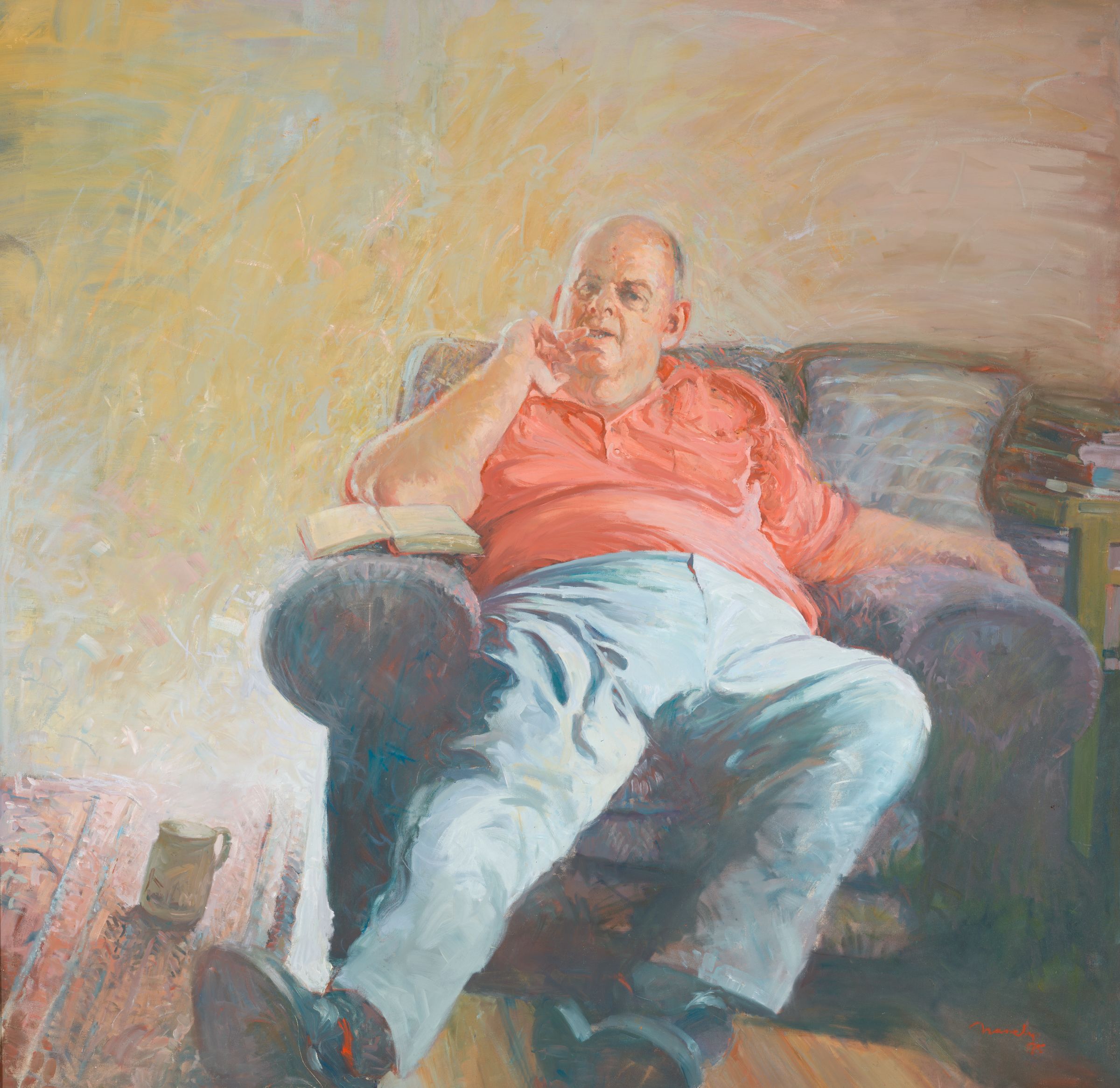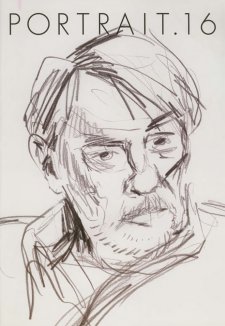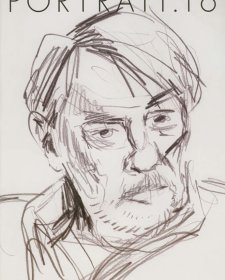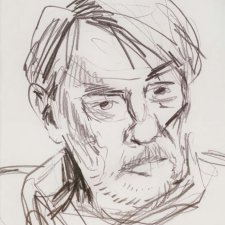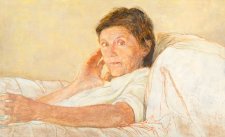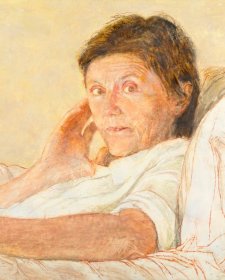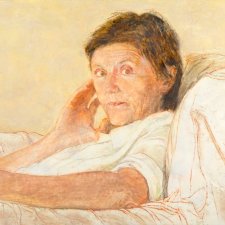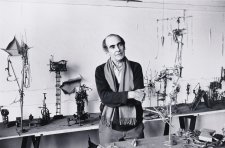If a traditional goal of the portraitist has been 'psychological penetration' of his or her sitter, a poet surely presents exquisite difficulties as a subject. The Portrait Gallery's paintings of two poets, Les Murray and Peter Porter, demonstrate two very different artists' responses to the challenge of representing more than usually sensitive and imaginative men.
These portraits, by Sydney portraitist David Naseby and London-based abstractionist Tony Clark, are two amongst the National Portrait Gallery's diverse collection of representations of leading Australian cultural figures, including - to take just one, interesting example - Charles Blackman's The Family, depicting another essential Australian poet, Judith Wright (1915-2000). The opportunity to view the two paintings side by side contributes a new note to a thirty-year-old dialogue between the men that still resonates in Australian literary studies.
Les Murray AO (b. 1938), arguably now the best-known Australian poet in the English-speaking world, has lived nearly all his life in Australia. Since the publication of his first (collaborative) volume, The Ilex Tree, in 1965, his many books have engaged with the values of the nation's rural heartland, in which he grew up and to which he returned to live in 1985. Sometimes characterised as 'bush baroque', Murray's poems deal with high emotion, often the sublime, but are expressed in vernacular, popularly accessible terms. He has garnered many Australian awards since The Ilex Tree won the Grace Leven Prize; his international honours include Germany's Petrarch Prize and the UK's TS Eliot Prize. He has in the past advocated a public, 'bardic' role for poets, and in 1998 the Federal Government commissioned him to write a new preamble to the Constitution, but much of the draft was rejected and he later dissociated himself from the fraught project. Murray's influence on Australian culture extends well beyond his poetry; he has been an editor for Angus and Robertson, Poetry Australia and Quadrant, and has published several volumes of essays on Australian themes and issues, including The Quality of Sprawl (1999). Peter Alexander's biography, Les Murray.' a life in progress was published in 2000, three years after Anurag Sharma's critical study, A Dimension of the Angel, was published in Jaipur.
Peter Porter (b. 1929) was born in Brisbane, where he started a journalist's cadetship in 1947. Three years later he moved to London, where he became poetry critic for The Observer. In the 1950s he was associated with a group known as 'The Group', coordinated by the remarkably influential Philip Hobsbaum, who was to foster a generation of top British writers in similar 'groups' in Belfast and Glasgow. His first collection of poetry, Once Bitten, Twice Bitten, was published in 1961. In 1974 Porter came to Australia for the Adelaide Festival. Over the next decade he was to collaborate with Arthur Boyd, and take up the first of several periods as writer-in-residence in Australian universities. Australian consciousness of Porter, described by Les Murray in 1978 as 'one of the few really first-rate intellectual poets left', developed over the 1 980s. He was awarded the Gold Medal of the Australian Literature Society in 1990, six years after Murray had received the same honour, and Bruce Bennett's critical biography, Spirit in Exile: Peter Porter and his poetry, was published in 1991. Over the last twenty years he has built up a body of 'Australian' poems that are characteristically more attuned to the natural world than his 'English' oeuvre, and has gained a reputation as one of the few poets able to encompass the different sensibilities of the two countries. Like Murray, he has received the Queen's Gold Medal for Poetry.
In 1975, 25 years after his expatriation, Porter published the poem regarded as the key to his relationship with Australia, 'On first looking into Chapman's Hesiod'. The poem takes its title from a sonnet by Keats, 'On first looking into Chapman's Homer', in which Keats expresses the profound impact on him of reading the 17th century translation of the Iliad, comparinghimself to an explorer to whom a long-sought land is at last disclosed. In turn, Porter described how reading Chapman's translation of poems by Hesiod (who came from Boeotia, a rural Greek region the 'provincial' culture and values of which conflicted with those of sophisticated Athens) threw new light on his own voluntary exile. Like the Boeotians, he wrote, Australians were blunt patriots, 'thick as headlands', who yapped like kelpies about their 'strange and baulking' land. By contrast, he recognised, he had found personal authenticity in a metropolis where 'speech is nature and plants conceive in pots/ Where one escapes from what one is and who/ One was'.
Porter and Murray first argued the virtues of metropolitan and rural modes at the Poetry Australia Write-In at Macquarie University in 1975. Later, Murray responded to Porter's poem, which he called 'one of the central works in our literature' in a seminal essay, 'On sitting back and thinking about Porter's Boeotia'. Porter's 'superb piece of cultural analysis', which incorporates a Murray-like figure 'philosophising on his dangling billies', confirmed the difference in the two poets' personal inspiration and communities as it highlighted the contrasting models of Western civilisation and art. At the same time, however, it revealed to Murray the 'ultimate non-urbanity of works we had thought were secure classics of Athenian art here' - for example, Slessor's 'Five Bells' - and ignited his hope that Australia might in time achieve a synthesis of urban and rural cultural expression unique in the world.
'If aristocracy is [Boeotia's] besetting vice,' Murraywrote, 'that of Athens is probably abstraction. Each has its price, artistically'. For some viewers, the way the friends are depicted in these two portraits may evoke elements of their approach to poetry: the mighty Murray, observationally, at his Bunyah home, his cup tilting 'like my life', as he said; Porter, more abstractly, the blue of his floating head Tony Clark's conscious and ongoing reference to the Anglicised classicism of Josiah Wedgwood's Jasper ware. The degree to which the collected work of each poet has influenced his portraitist's vision remains to be explored.
